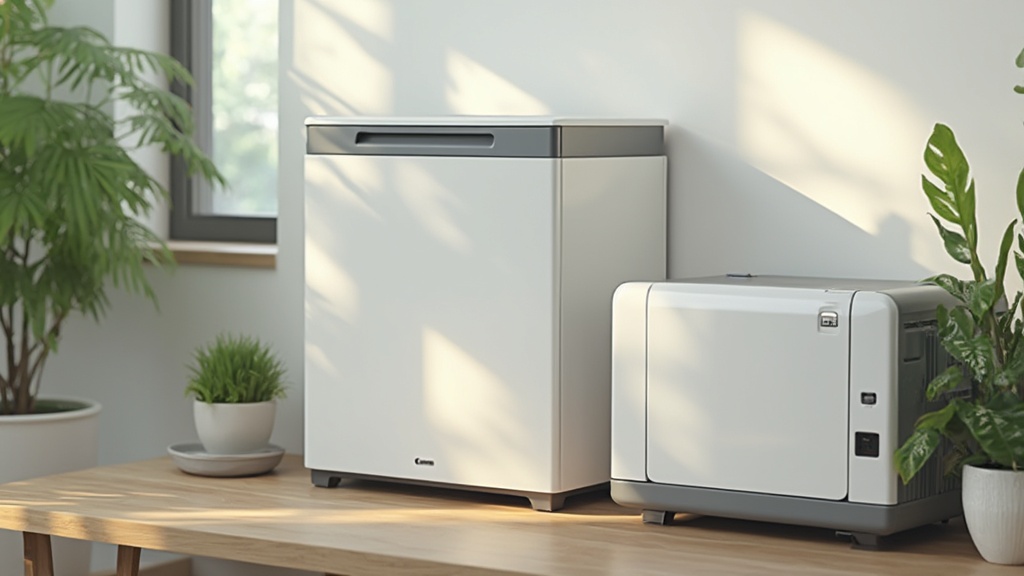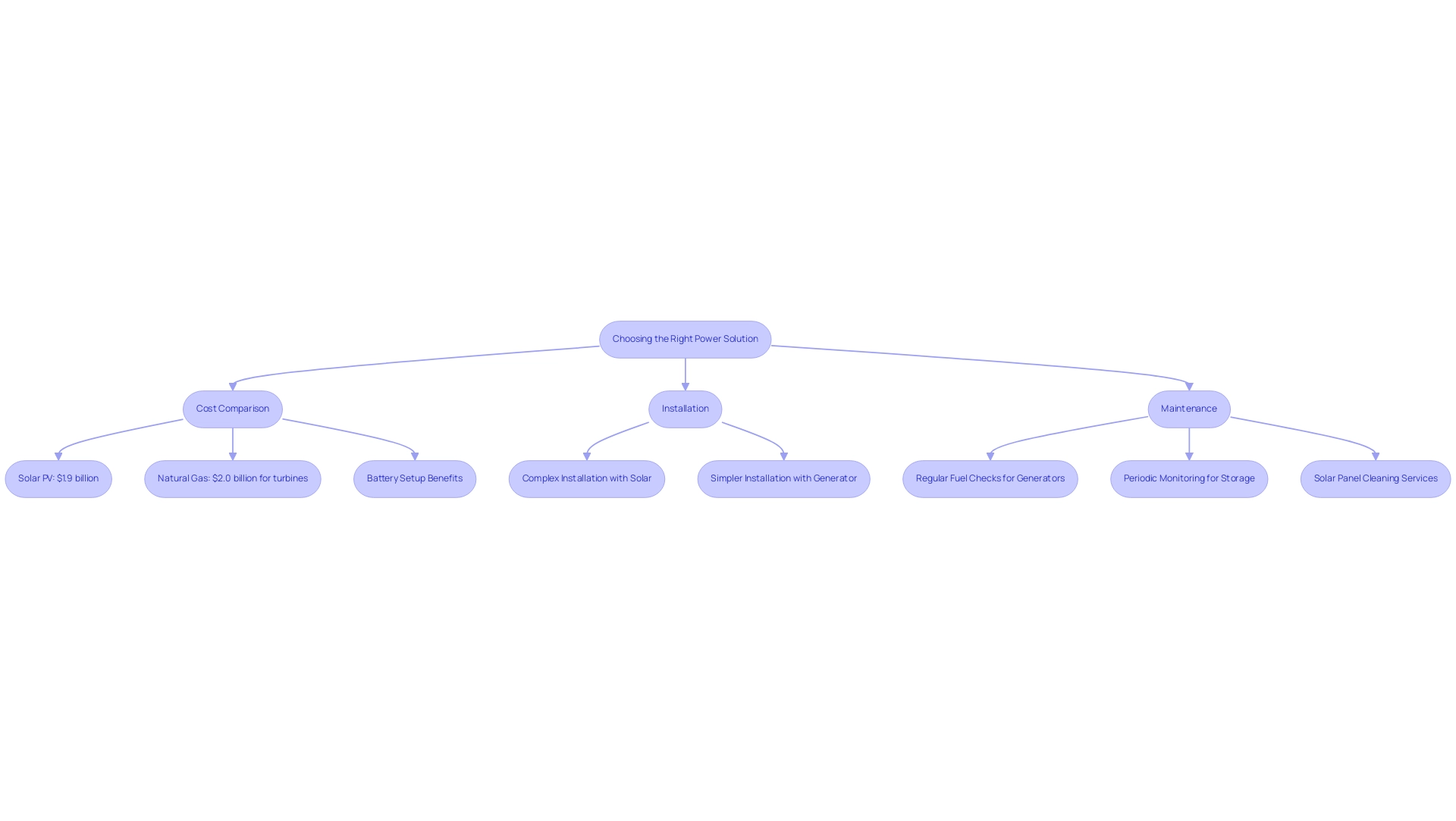Introduction
As homeowners increasingly seek sustainable energy solutions, understanding the intricacies of battery storage and generators becomes paramount. With the growing adoption of battery systems, particularly in 2024, these technologies are transforming how energy is managed in residential settings. Unlike traditional generators, which often rely on fossil fuels and can disrupt the tranquility of a home, battery storage systems offer a quieter, cleaner alternative that harnesses renewable energy.
This article delves into the essential concepts surrounding battery storage and generators, exploring their advantages, installation considerations, and the latest innovations shaping the future of home energy solutions. By examining the various options available, homeowners can make informed decisions that not only enhance their energy efficiency but also contribute to a more sustainable future.
Understanding Battery Storage and Generators: Key Concepts for Homeowners
Battery retention systems are crucial for optimizing power consumption by holding surplus power produced from renewable sources such as solar panels for future use. This capability is becoming progressively important, particularly with a rise in energy reserve usage anticipated in 2024. In 2023, the on-grid category accounted for a considerable portion of the market, indicating a rising trend towards power retention solutions.
While a generator with battery storage is frequently utilized during outages or when power demand surpasses supply, storage solutions stand out for their silent operation and significantly lower emissions, making them an eco-friendly option for homeowners. Innovations in the residential power storage market highlight the advantages of these setups, providing a convincing substitute for conventional generators with battery storage that usually operate on diesel or gasoline, which can generate noise and increased emissions. For instance, the Bluetti EP900, recognized for its modular design and 9 kW output, is a dependable option that showcases the benefits of contemporary energy storage systems.
By understanding these distinctions, you can align your solutions with your sustainability goals. Moreover, recent advancements demonstrate how power retention is being incorporated into different building types, emphasizing the practical significance of solar units for homeowners aiming to improve their resource management and assist in a cleaner future. Additionally, consider the financial incentives available, such as net metering in Massachusetts, which can significantly reduce the costs associated with acquiring a power reserve unit.
Lastly, it’s important to compare various power source types:
- Lead-Acid
- Lithium-Ion
- Flow Systems
to determine which best suits your requirements and budget.
Choosing the Right Power Solution: Comparing Costs, Installation, and Maintenance
When evaluating cost comparisons, it’s essential to recognize that energy retention solutions frequently have a greater initial expense because of the cells involved. For instance, crystalline silicon solar PV plants can reach a total cost of around $1.9 billion. In contrast, natural gas generators typically require a smaller initial investment, with combined cycle plants costing about $2.0 billion for combustion turbines and $1.1 billion for steam turbines.
However, don’t forget to think about the bigger picture! Battery setups that include a generator with battery storage can result in considerable long-term savings on energy expenses, enabling homeowners to use stored energy during peak demand periods when rates can soar. For instance, the Tesla Powerwall can supply a 100-watt light bulb for around 135 hours or a 500-watt refrigerator for 22.5 hours, demonstrating the practical advantages of energy storage.
Additionally, government programs often provide incentives for homeowners investing in these technologies, making them more accessible. Now, let’s chat about installation. Battery setups can be a bit more complex, as they need to integrate smoothly with existing solar configurations, while a generator with battery storage usually has a more straightforward installation process.
Maintenance is another key factor; generators require regular fuel checks and oil changes to operate effectively, whereas storage units need periodic monitoring to ensure top performance. Furthermore, considering solar panel cleaning services can help maintain efficiency and prolong the lifespan of your solar investment. By understanding these factors and exploring specific power storage options like the LG Chem RESU and Sonnen Eco, you can make a well-informed decision that aligns with your requirements and eco-conscious lifestyle.
The Advantages of Hybrid Systems: Integrating Battery Storage with Generators
Hybrid power setups provide a wonderful opportunity for environmentally aware homeowners to enhance their power solutions by combining accumulator facilities with a generator with battery storage. This innovative arrangement not only facilitates efficient power storage but also provides a dependable backup power source through a generator with battery storage. During peak power demands, the setup cleverly prioritizes battery usage, significantly minimizing wear and tear on the generator.
This strategic method results in reduced maintenance expenses and a longer lifespan for your equipment. Furthermore, hybrid solutions enable you to attain greater power independence, decreasing your dependence on the grid and promoting a more sustainable way of living. Recent studies emphasize that hybrid renewable power solutions can sustainably meet and exceed future power requirements, particularly when bolstered by focused research and supportive policies.
With projections indicating that cumulative heat-related emissions could surpass 100 Gt CO2 from 2024 to 2030, adopting these solutions has never been more urgent.
When choosing a solar battery, key considerations include:
- Capacity
- Efficiency
- Lifespan
- Price
For example, the Tesla Powerwall offers a capacity of 13.5 kWh, an efficiency rating of 90%, and a lifespan of up to 10 years, making it a popular choice among homeowners. Likewise, the LG Chem RESU offers a compact design featuring a capacity of 9.8 kWh and a warranty of 10 years, serving those with restricted space.
Excitingly, renewable auctions and incentives for distributed solar PV in the EU are set to stimulate capacity growth, further promoting the uptake of these solutions. For instance, a concrete contractor tackled the challenge of conditioning concrete overnight in freezing temperatures while adhering to strict noise ordinances. By utilizing the POWRBANK Battery Storage solution, they ensured continuous power and saved over 4,500 kg of carbon emissions—equivalent to nearly eight months of electricity for an average household.
Looking forward, the International Energy Agency (IEA) indicates that addressing major challenges in policy and grid integration could unlock nearly 20% more capacity, potentially tripling global renewable capacity by 2030. This highlights the crucial function of hybrid approaches in not only reducing operational expenses and emissions but also in promoting a sustainable power landscape that benefits us all.
Environmental Considerations: Sustainability of Battery Storage vs. Generators
When it comes to sustainability, a generator with battery storage solutions shines brightly compared to traditional fossil fuel generators. These innovative technologies, including a generator with battery storage, produce zero emissions during operation and can be charged using renewable energy sources like solar or wind, making them an eco-friendly choice for California homeowners. In contrast, fossil fuel generators release harmful pollutants that contribute to greenhouse gas emissions, negatively impacting our air quality and climate.
As eco-conscious homeowners, it’s crucial to consider not just the efficiency of these setups but also their lifespan and recycling options. Many manufacturers are making strides toward improving battery sustainability, which makes these solutions even more appealing. Just as T.C. emphasizes,
‘It is important to highlight the need for clear and comprehensive regulation that guarantees the safety, reliability, and accessibility of these technologies for all users of the electrical system.’
Furthermore, with a growing commitment to sustainable power solutions, the shift towards renewable options is gaining momentum. While temporary rises in emissions may occur due to extreme weather or policy changes, a broader decline in power sector emissions is expected as renewables and nuclear power expand.
This commitment not only benefits the environment but also aligns with the increasing trend of renewable resource adoption, as seen in recent shifts in electricity demand patterns across the European Union. So, when considering your choices, keep in mind that selecting a generator with battery storage not only contributes to a cleaner planet but also embraces a future centered on sustainable power solutions—just like Powercore Electric is committed to delivering customized solutions that address the unique needs of our local communities. Our clients have expressed their satisfaction, stating,
‘Powercore Electric transformed our power usage with their expert installation and support,’
highlighting our unmatched quality craftsmanship.
We take pride in ensuring that every installation meets the highest standards of quality and safety, making your experience seamless and stress-free.
Future Trends in Home Energy Solutions: Innovations in Battery Storage and Generators
The future of residential power solutions is on the verge of major innovation, especially in storage technology. Homeowners can anticipate batteries that feature longer lifespans and quicker charging times, making power management more convenient than ever. Alongside these advancements, eco-friendly solar panel cleaning options are becoming increasingly essential for maintaining the efficiency of solar systems.
As homeowners prioritize sustainability, they can benefit from cleaning solutions that are not only effective but also environmentally friendly. Additionally, the integration of smart technology promises to simplify resource consumption management. Homeowners will be able to enhance the use of both storage systems and a generator with battery storage, creating a smooth power experience.
The increase of renewable power sources naturally leads to the development of hybrid systems that utilize a generator with battery storage, ensuring they are efficient and user-friendly. For instance, lithium iron phosphate (LFP) cells have become a game-changer, supplying over 40% of global electric vehicle demand in 2023, primarily due to their production in China. The expiration of core LFP patents has sparked interest in manufacturing outside China, inviting investment in regions like Morocco, which could enhance local power solutions.
Furthermore, sodium-ion cells are emerging as an alternative influenced by lithium prices, reshaping the energy storage landscape. As we progress into 2024 and beyond, trends suggest that the average cost of lithium-ion batteries is anticipated to decrease further, potentially approaching around USD 82/kWh by 2025, motivating more homeowners to embrace smart technology in their management. Significantly, Tesla home chargers are gaining popularity among eco-conscious homeowners, offering efficient charging solutions that integrate seamlessly with solar power systems.
The scheduled start-up of the fourth reactor at Georgia’s Vogtle nuclear power plant in March 2024 heralds an evolution in power production, enhancing the reliability of sources. Lastly, advancements in other power storage segments, such as nickel-cadmium, nickel-metal hydride, and alkaline types, also play a crucial role in diversifying solutions while supporting the overarching goal of a greener, more sustainable future. By considering the best solar battery choices, such as the Tesla Powerwall and other leading brands, homeowners can make informed decisions that align with their energy needs and sustainability goals.
Conclusion
Battery storage systems and generators are pivotal in shaping the future of home energy management. As the article emphasizes, battery systems provide cleaner, quieter, and more efficient energy solutions, particularly as homeowners increasingly adopt these technologies in 2024. The ability to store excess energy from renewable sources not only enhances energy independence but also aligns with sustainability goals, making them an attractive alternative to traditional generators.
Cost considerations, installation complexities, and maintenance requirements are crucial factors to weigh when deciding between battery storage and generators. While battery systems may have a higher upfront cost, the long-term savings on energy bills and environmental benefits often outweigh the initial investment. Moreover, hybrid systems that integrate both technologies can maximize efficiency and reduce reliance on fossil fuels, ultimately supporting a greener lifestyle.
As innovations in battery technology continue to evolve, homeowners can expect improved performance, longer lifespans, and greater accessibility. The push towards renewable energy solutions is not just a trend; it represents a fundamental shift in how energy is consumed and managed in residential settings. Embracing battery storage systems not only contributes to a cleaner planet but also empowers homeowners to take charge of their energy future, ensuring that they are well-prepared for the challenges and opportunities that lie ahead.



